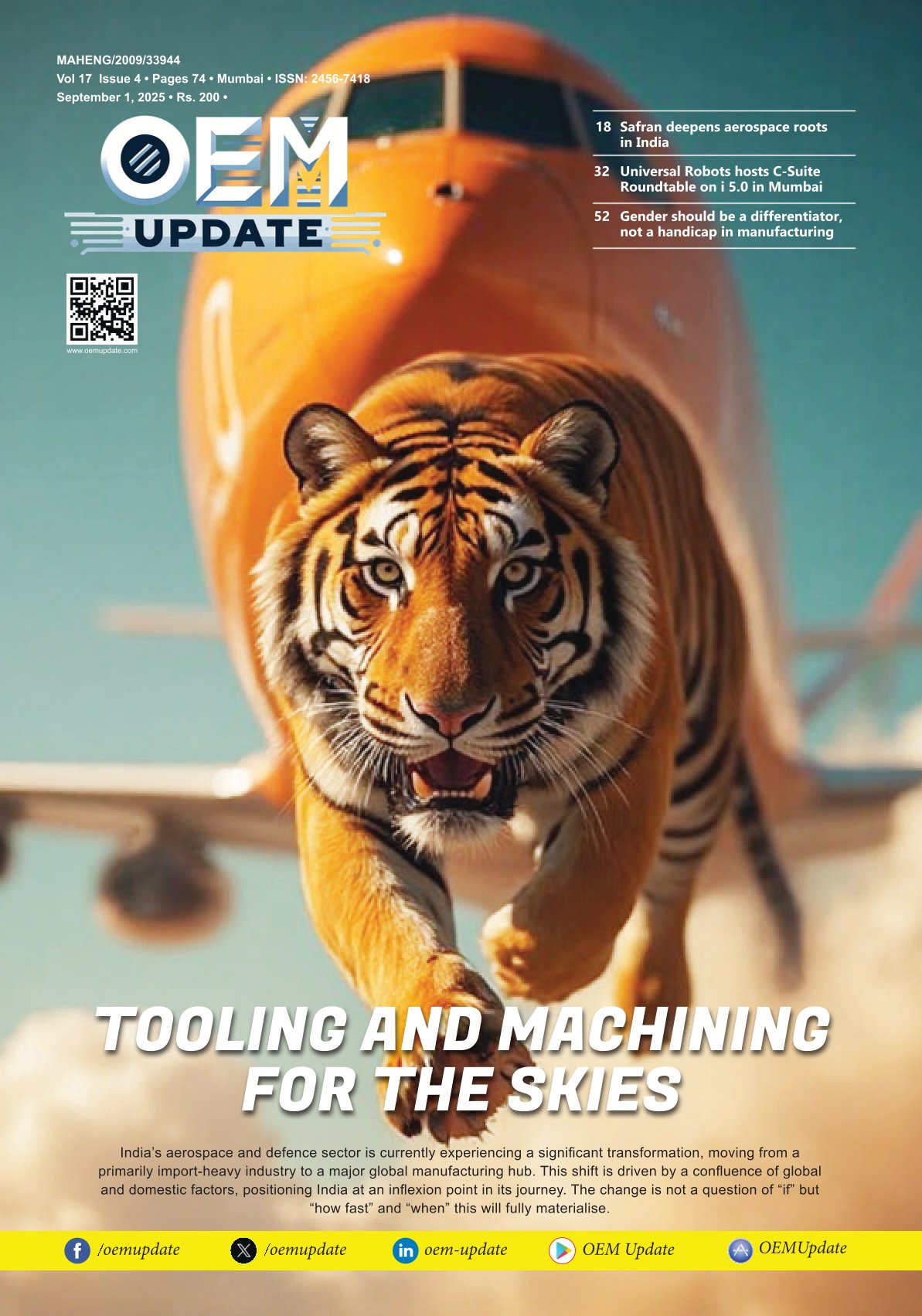Advanced aerospace engine production: expertise and manufacturing methods
By admin December 4, 2013 7:17 am IST
increasingly difficult-to-machine materials, complex geometries, exacting specifications and constant time restraints, the manufacture of aerospace parts has many limitations; still, production rates are set to increase
Aerospace is one of the most technically demanding industries in the world. With increasingly difficult-to-machine materials, complex geometries, exacting specifications and constant time restraints, the manufacture of aerospace parts has many limitations; still, production rates are set to increase.
Total component expertise is the key to success in such a competitive manufacturing landscape. These and other challenges dictate a production environment with complicated four- and five-axis machines driven by CAM solutions. Choosing an industry partner that has the experience and resources to support all aspects of individual component development, including both the physical tool and the processing knowledge is crucial in this highly competitive industry.
Total solution support should encompass spindle interface, tool holder selection, programming methods, insert grade and geometry, and surface integrity – all of the parameters that will produce the highest-quality parts. Aligning and optimising these factors will help you compete on a global scale.
A look at aero engine components The aerospace industry specifications, the nature of the materials and the component configurations all create some of the most challenging machining operations. These components are made up of some of the most difficult-to-cut materials and complex shapes, requiring extensive tool reach and the right tool path.
These high-temperature operations create demands for materials that are harder, stronger, tougher, stiffer and more resistant to corrosion or oxidation, such as nickel alloys, high-strength titanium, high-alloy steels and composites. These materials have much lower machinability than other, more common materials, and require a great deal of processing knowledge. You can optimise machining productivity with the right combination of cutting tools, cutting conditions and machine tools.
Engine components are demanding workpieces due to their complex geometries. They are often extremely large in size, with critical strength and weight restrictions. This is achieved with thin walls, intricate geometries, and complex shapes – all presenting new challenges in machinability.
Here we take a look at the machining challenges of certain aero engine components, and then show how combining the latest application and process knowledge with the best possible tooling solutions can be the key to success.
Component: Turbine DiscThe turbine disc is a complex turned part machined from difficult alloys such as Inconel 718, Waspalloy and Udimet 720. This component usually features profiled pockets with difficult clearance requirements.
Tooling Solution: The modular SL70 tooling systemDue to tough material, accessibility and productivity, round inserts offer the best method for both roughing and finishing. The large radius of these round inserts means a reduction in the entering angle without reducing the depth of cut, therefore increasing productivity. The modular SL70 tooling system is designed with blades to fit restricted pocket features without the need for special or modified tools. The range of adapters and blade alternatives for the tool gives it the flexibility to build many different tools from a limited tool inventory. These blades include the required radial and axial clearances for blades reaching deep into angled grooves with high-pressure coolant supplied through the tool to the cutting edge. Having built-in dampening for ensuring performance at extended tool reach, these blades turn features in deep grooves often at higher feed rates causing less vibration and increased tool life. In addition, the Coromant Capto interface provides excellent stiffness even in long overhangs and against high cutting forces.
Application: Trochoidal TurningTrochoidal turning is a productive method for removing material in deep slots and grooves. By breaking the part into manageable pieces, trochoidal turning uses a roll-into-cut approach to reduce engagement on the insert. When producing grooves by turning, chip evacuation is always a critical factor. Because the material is being highly sheared, generating narrow chips is often more demanding, and requires a balance between the most suitable insert geometry and feed rate. It also maximises straight line movements, which enables max feed rates for optimal productivity. This approach involves changing the cutting direction at the end of every pass. Alternating the direction of the cut makes the insert last longer because it never leaves the material. Trochoidal turning minimises chip jamming, vibration tendencies and residual stress, and is well suited to remove a large amount of material efficiently and securely.
Component: Turbine CasingThe turbine casing is typically machined from challenging materials such as Inconel or Waspalloy. The structure of these components poses significant problems during milling due to the large amounts of material that must be removed. These components require a significant number of mill-turn and 5 axis operations to remove large amounts of material, resulting in very long cycle times.
Tooling Solution: Ceramic Grade CC6060Ceramic cutting tools have a much higher resistance to heat than carbide tools and have low reactivity with workpiece materials. Ceramic grade CC6060 is optimised for large-diameter components with long cutting lengths that allow it to cope with higher feed rates and longer continuous cuts, making it ideal for milling operations on turbine casing components. Excellent resistance to notch wear allows for higher depth of cut than other ceramic grades, for optimal productivity in medium to roughing operations in first- and intermediate-stage machining. The grade is also the first choice for pocketing and profiling operations.
Application: Ceramic turn milling between bossesOn average 75 per cent of the total turbine casing machining is spent on removing material using mill-turn operations between the bosses. Mill-turning involves cutting with a rotating milling tool while the workpiece is also rotating. This operation is ideal for turned parts that require high metal removal and have obstructions such as ignition bosses. Turbine casing bosses are located around its cylindrical perimeter. Turn-milling with ceramic inserts reduces notch wear, increases feed rates and achieves higher metal-removal rates – it is the most productive way to remove material between bosses.
Tooling Solution: Vertical Turning Lathes (VTL)To achieve the unique combination of temperature control and superior component accuracy, machining should be done on a vertical turning lathe. VTLs by design need to have either manual quick-change or automatic tool-change. Particularly with automated tool changing, long chips present a high risk to component damage. However, with the coolant piped through the ram directly to the spindle, there are no coolant pressure restrictions, improving cutting conditions and process security. Application: High-pressure coolant (HPC)One key to success in the machining of fan casings is the use of high-pressure coolant. HPC improves chip control and reduces the temperature in the cutting zone. Chip control is more secure, ensuring evacuation from tight pockets and grooves. This guarantees that the chips won’t wrap around tools or drag across the component. Effectively cooling the machining zone will help minimise tool wear, prolong tool life by up to 50 per cent, and provide a potential for 20 per cent higher cutting speed.
While the machine’s pump can provide the pressure, getting the coolant to the right place is the responsibility of the tool. Making use of high-precision nozzles, coolant is directed to the main cutting edge. This effective application can help evenly distribute and reduce heat during machining.
Components: Spool and Fan Disc The engine spool and fan disc present two of the same challenging features: deep internal chambers and tulip grooves.
Tooling Solution: Dampened Blades Using dampened blades on these components will help control the common challenges of vibration and chip removal. Dampened blades are designed with a patented dampening device, for a more productive and secure process. This allows depth of cut to be 4 times greater than without dampening. These slender tools can access and effectively remove chips from the deep internal chambers for an extremely secure machining process.
Application: Vibration-free turning in deep grooves Deep grooves present one of the most challenging features of these components. Deep grooving on spool applications can result in chip build-up in the pocket and lead to insert failure. For a more secure process, use vibration-free turning. Oval serration blades provide the best stability and accessibility, while 3 to 10 inch high blades allow for the best coolant delivery to assist in chip removal.
Component: ShaftThe engine shaft is made from high-alloy steel or inconel; its primary machining challenge is the length and internal features of the component. The biggest development in shaft manufacturing has come from the evolution of the multitask machine.
Tooling Solution: Silent Tool dampened boring bar Because of this component’s length, vibration can be a common problem during boring applications. Vibrations may cause problems such as bad surface texture, insufficient accuracy, loss of productivity, increased insert and machine tool wear, and noise. Silent Tool boring bars have a built-in dampening mechanism, making it possible to machine without vibration and still maintain good productivity and close tolerances.
Application: Boring in deep cavities and holesBoring in deep holes can lead to poor surface finish and vibration due to instability. The only cutting force component that does not need to be counteracted with support is the axial force. However, the radial force bends the tool out and away from the cutting zone in such a way that the tolerance and diameter of the hole is negatively affected. By applying increased axial load and radial load, the present frequency or a silent tool dampened bar absorbs any vibration in cut, improves chip control, and can run at increased cutting data.
Component: Blisk/Impellor Blisks are becoming more common in engines’ high-pressure compressors due to the advantages of weight, efficiency and servicing. This component has narrow pockets, slots, and deep complex geometries, more so than other components, that often requires 5-axis machining movements. Key factors to machining success include five-axis machinery with good simultaneous dynamics, optimised software and a proper tooling selection.
Tooling Solution: Plura 50-degree relieved shankWhen roughing a slot in inconel, the Plura 50-degree relieved shank, with a bull-nose design, is optimised for axial depth of cut twice the diameter and low radial cuts, for a high-speed process.
Application: Trochoidal MillingTrochoidal milling is a high-speed machining technique for removing material in scallops and pockets. This application uses a roll-in entry and exit from the cut to control the arc of engagement, for higher productivity and improved tool life. Trochoidal milling enables high table feeds in combination with low cutting forces; generating low cutting edge and workpiece temperatures. This method utilises the technique of chip thinning, resulting in less heat build-up in the chips and allowing the tool to run in at full depth. In addition, this can also cut down the number of passes. Trochoidal milling is not always the fastest method for roughing in slots, but does result in better tool life, better predictability, and a better quality part.
In today’s global manufacturing environment, the demands of working with critical parts on high value machine tools can be exceptionally tricky without the right process knowledge and best-practice machining strategies. Having the right resources to support you on all levels will keep you competitive globally with process improvements, increased productivity, quality consistency, cost reduction and process security.
Author: Sean Holt, Aerospace Application Manager, Sandvik Coromant USVisit www.aero-knowledge.com for these and other aerospace component solutions from Sandvik Coromant. Learn more about trochoidal turning, trochoidal milling, and other CAM programming tips at www.MyYellowCoat.com/cam-tips
Cookie Consent
We use cookies to personalize your experience. By continuing to visit this website you agree to our Terms & Conditions, Privacy Policy and Cookie Policy.
















